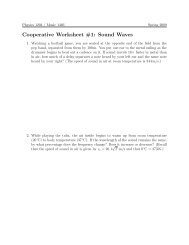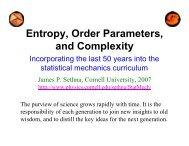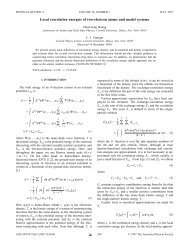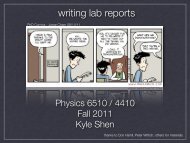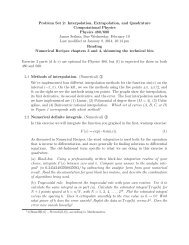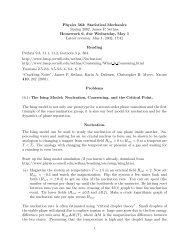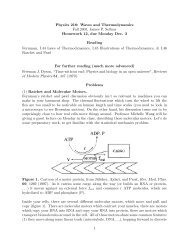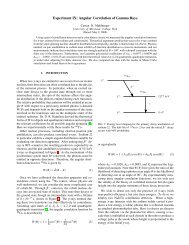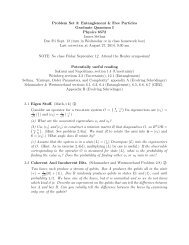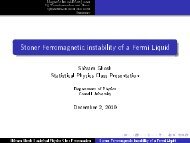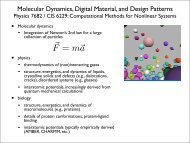Computational Methods for Nonlinear Systems
Computational Methods for Nonlinear Systems
Computational Methods for Nonlinear Systems
- No tags were found...
You also want an ePaper? Increase the reach of your titles
YUMPU automatically turns print PDFs into web optimized ePapers that Google loves.
<strong>Computational</strong> <strong>Methods</strong> <strong>for</strong><strong>Nonlinear</strong> <strong>Systems</strong>Cornell Physics 682 / CIS 629James P. SethnaChristopher R. Myers
<strong>Computational</strong> <strong>Methods</strong> <strong>for</strong> <strong>Nonlinear</strong> <strong>Systems</strong>• Graduate computational science laboratory course- lectures are minimal- class work focused on self-paced implementation of computer programsfrom hints and skeletal code•••Developed originally to support Cornell IGERT program in nonlinear systems- graduate fellowship program supporting interdisciplinary group of students- also listed in graduate curriculum in Physics, CS&E, <strong>Computational</strong> BiologyHands-on introduction to scientific computing, algorithms, programming, andsimulation techniques- in the context of IGERT focal themes: complex networks, biolocomotion &manipulation, pattern <strong>for</strong>mation, and gene regulation- also includes: statistical mechanics, chaos in nonlinear systems, moleculardynamics, random matrix theory, constraint satisfaction, etc.Most exercises incorporated into Sethna’s textbook, “Statistical Mechanics:Entropy, Order Parameters, and Complexity”
Programming• all programming done in Python (www.python.org)- 3rd party Python libraries <strong>for</strong> numerics, graphics, visualization, etc.- e.g., SciPy, NumPy, pylab, PIL (Python Imaging Library)•course hints files provide documented code fragments to be fleshed out bystudents• graphical tools provided to give immediate feedback, help debug, etc.•why Python?- interpreted: rapid program development and interactive access- built-in data structures & high-level syntax- rich standard library and 3rd party libraries (<strong>for</strong> science, visualization,databases, internet programming, etc.)- supports procedural programming, object-oriented programming,functional programming, scripting, large systems- free software (monetarily and intellectually)
Important third-party Python modules• NumPy (Numerical Python) [www.scipy.org/NumPy]- grew from a merger of Numeric and numarray; converging toward version 1.0- provides (in a compiled library) high-level array syntax, linear algebra, randomnumber generation, Fourier trans<strong>for</strong>ms••••SciPy [www.scipy.org]- Python interfaces to well-tested compiled numerical routines, interfaced to workwith NumPy arrays- provides routines <strong>for</strong> integration of functions and differential equations, rootfinding,minimization, etc.pylab (a.k.a. matplotlib) [matplotlib.source<strong>for</strong>ge.net]- provides 2D (x-y) plotting, histograms, etc.Python Imaging Library (PIL) [www.pythonware.com]- image creation and manipulation- <strong>for</strong>ms the basis of several course visualization modulesipython [ipython.scipy.org]- enhanced alternative to the standard python interpreter- command completion & history, “magic” functions, etc.
Course modulesSmall-world networksInvariant measureCardiac dynamicsNP-completenessPercolationChaos & LyapunovRandom matrix theoryIsing modelPendulumFractal dimensionsStochastic cellsMolecular dynamicsplus a few othersWalkerPeriod doublingRepressilator
Small-world networks• Science- small world networks (Watts & Strogatz)- “six degrees of separation”- shortest path lengths in randomly wiredgraphs• Computing- data structure <strong>for</strong> undirected graphs‣ good introduction to built-in Pythoncontainers (lists and dictionaries)- object-oriented encapsulation of complexdata structures- graph traversal algorithms (breadth-firstsearch) <strong>for</strong> shortest path andbetweenness- simple graph visualization softwaresupports debugging and provides quickfeedback
Percolation• Science- statistical mechanics of percolation‣ connected clusters in randomly wiredgraphs (e.g., bond percolation on alattice)‣ universality of phase transitions• Computing- reuse of objects with generic interface(reuse of UndirectedGraph class fromsmall-world network module)- graph traversal algorithms (breadth-firstsearch) <strong>for</strong> cluster finding- scaling collapses
Walker• Science- Simple model of bipedal walker (Ruina andcoworkers)‣ double pendulum with impulse <strong>for</strong>heelstrike‣ single pendulum as warmup- period-doubling bifurcations in physicalsystem• Computing- integration of ODEs‣ finite differences, time-step dependence,integration schemes (stability, fidelity,accuracy)‣ calling 3rd party numerical libraries- change of integration variables <strong>for</strong> eventdetection (heelstrike)- tracking unstable periodic orbit- uses VPython visualization tools <strong>for</strong>animation
Maps & dynamical systems• Science- bifurcations and chaos in iterated maps- period doubling in logistic map- density (invariant measure) in chaoticregime- Lyapunov exponents: divergence ofnearby trajectories- fractal dimensions of attractors- renormalization group of logistic map &universality of period doubling route tochaos• Computing- iterating maps- root-finding- fitting
Cardiac dynamics• Science- pattern <strong>for</strong>mation in excitable medium- FitzHugh-Nagumo model (type ofreaction-diffusion equation)- spiral defects <strong>for</strong>ming in electricalpulsing can lead to cardiac arrythmias- model extensions to simulate deadtissue, cardiac chambers, etc.• Computing- numerical solution of PDEs‣ finite-differences, operator stencils- nullcline analysis <strong>for</strong> single cell (rootfinding)- simple animation tool allows interactivesteering of simulation (needed toprovide targeted electrical pulses and“defribrillator” shock)
Cell dynamics: stochastic cells and Repressilator• Science- Repressilator (Elowitz & Leibler): geneticoscillator from realm of synthetic biology‣ oscillatory mRNA/protein dynamicsfrom mutually repressing proteins- telegraph noise and shotgun noise instochastic systems• Computing- chemical kinetics and reaction networks‣ Petri nets‣ synthesis of aggregate kineticequations from network- Monte Carlo algorithms (Gillespie)- stochastic vs. deterministic descriptions
NP-completeness & constraint satisfaction• Science- NP-complete problems- phase transitions in 3SAT andparametric complexity- integer partitioning problem• Computing- algorithms <strong>for</strong> NP-completeproblems- backtracking, recursion
Random matrix theory• Science- eigenvalue spacings in randommatrices- developed originally to describeenergy level spacings in quantumsystems• Computing- random matrix generation- eigenvalue computation (numpy)
Molecular dynamics• Science- thermodynamics: emergence ofeffective properties frommolecular chaos• Computing- design of large software systems- geometric data structures- integration of ODEs- thermodynamics‣ pressure‣ pair distribution functions
Ising model• Science- phase transitions in simplemodel of magnetic system‣ nucleation‣ self-similarity‣ fluctuation-dissipation• Computing- Monte Carlo algorithms‣ heat bath‣ Metropolis‣ cluster flipping
Randomness: random walks & Gumbel distributions• Science- ensembles and distributions‣ averages‣ extremal behavior‣ emergent symmetries• Computing- random number generation- statistical analysis of ensembles
Working with course modules• Course web page- www.physics.cornell.edu/sethna/teaching/<strong>Computational</strong><strong>Methods</strong>••Module web pages- www.physics.cornell.edu/sethna/StatMech/ComputerExercises.html- linked from “Computer Exercises and Hints” on course web pageFor a given module:- download (and print out, if desired) “Exercise” pdf file (e.g., Small World Exercise)- download “Hints” file and save to disk (e.g., SmallWorldNetworksHints.py)- copy “Hints” file to working file (e.g., cp SmallWorldNetworksHints.pySmallWorldNetworks.py)- edit working file (e.g., emacs SmallWorldNetworks.py)- read exercise file and comments in working/hints file- remove Python instruction “pass” and fill in body of code to implement exercise- start up ipython interpreter- run the module (e.g., %run SmallWorldNetworks.py)



